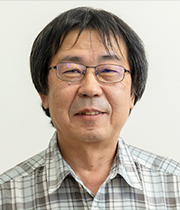The Herbarium of Hiroshima University plays a central role in the research activities
of “the
only bryophyte-specialized laboratory in Japan”
Hiroshima University has established the Herbarium of Hiroshima University (HIRO), whose central part is constituted by the “bryophyte collection,” a collection of mosses, liverworts and hornworts. With more than 600,000 specimens, this collection boasts the second largest scale of its kind in Japan after that of the National Museum of Nature and Science as well as the largest scale of its kind at universities in the country. This herbarium consists of specimens that have been collected by many researchers, including past professors at our university, since prewar days. In addition to a continuously growing number of collections, even in terms of the rarity of individual specimens, such as species contained only here and extinct species, this herbarium is obviously precious.
As the one and only Japanese research organization with such a large-scale and historical herbarium, the laboratory has constantly made unique findings.
Prof. Yamaguchi, the current leader of this laboratory, proudly says: “Our laboratory was established in 1929, as long as 90 years ago. At the same time, our research on moss-like plants started. Since then, most of the leading bryophyte researchers in Japan have been graduates of Hiroshima University, the only Japanese university that has a bryophyte-specialized laboratory.”


Prof. Yamaguchi conducts research on bryophytes while managing the herbarium. “The maintenance and curation of the herbarium make up an important part of our jobs. They are essential for my research activities and for those of other researchers, especially young researchers,” he says. In fact, the laboratory receives many inquiries from other universities and the like, which often lead to mutual exchange of desired specimens.
The central area of Prof. Yamaguchi’s research is “taxonomic and phytogeographical research on bryophytes.” Particularly, he specializes in “systematic taxonomy of the family Leucobryaceae in the phylum Bryophyta” and “clarification of regional bryophyte flora.” The ultimate goal of his research is “the taxonomic clarification of bryophytes all over the world and the clarification of the systematic associations between individual bryophyte species.”
However, this goal is naturally impossible to achieve only by himself. Therefore, he personally aims to clarify the taxonomy and system of bryophytes found in Japan and other East Asian regions.
Prof. Yamaguchi is currently engaged in research on bryophytes on islands in Japan. “To be more specific, the Ogasawara Islands and the Ryukyu Chain are the areas of my interest. Particularly, I explore areas that have not been investigated before, such as uninhabited islands. Since islands are separated from other landmasses, they are advantageous for phytogeographical research,” he says.
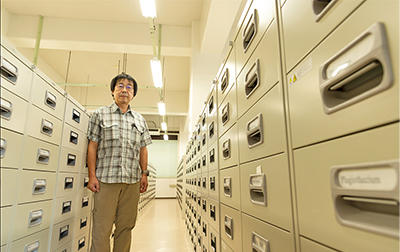
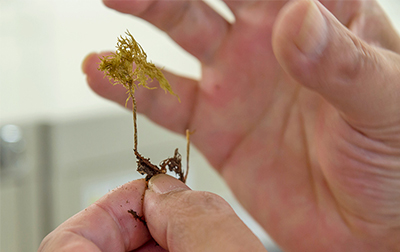
Attracted by bryophytes, he entered the Graduate School of Hiroshima University,
the starting
point of his life as a taxonomist
Prof. Yamaguchi’s interest in plants began when he was a junior high-school student. Since he liked walking in the mountains, he frequently went to the mountains, harvested plants, made specimens, and read many illustrated field guides and other specialized books. Due to his longing for southern islands, he chose a university in the southern part of Japan and majored in a biology-related subject. What he encountered there was “research on bryophytes.”
“When I had to decide the theme of my research at that time, I recognized that many of my schoolmates were far more knowledgeable about biology and nature than me. To differentiate myself from others, I had to study something different from what they were studying. For this reason, I chose bryophytes, a research subject that was different from that of others and a field that few people selected. The title of my graduation thesis was “Bryophytes on Iriomote Island,” he says.
Of course, he did not have any bryophyte specialists around him. Therefore, he began studying hard almost by himself while occasionally making contact with teachers and graduate students of his laboratory at Hiroshima University for advice and collecting relevant literature. To learn more deeply, he entered the Graduate School of Hiroshima University. He says that the laboratory was exactly an ideal environment for him because he could study under Dr. Zennoske Iwatsuki, who is known as an author of illustrated field guides to mosses, surrounded by a large number of moss specimens.
The campus to which he commuted at that time was still located in Higashisenda-machi, Hiroshima City. In addition to having a superb instructor, the presence of the herbarium was extremely significant for him. “We cannot see the details of bryophytes only through books. We need to observe real things, compare them with specimens, and investigate various things. In this sense, it was very important, in the first place, that there was a collection of specimens available at hand,” Prof. Yamaguchi says.
Since then, Prof. Yamaguchi has pursued his life as a taxonomist of bryophytes. According to him, taxonomy is divided into three levels: alpha, beta and gamma. The alpha level is the category in which researchers go to the mountains, harvest specimens, find new species, and describe them. At the beta level, researchers investigate associations between new species and other species, or systems. The gamma level, at which researchers investigate how new species were created, corresponds to the fields called “biosystematics” and “species biology.” Prof. Yamaguchi’s research corresponds to the alpha and beta levels.
One of the characteristics of Prof. Yamaguchi’s research style is that he places extra importance on field work. “It may be more appropriate to categorize my research activities as natural history rather than taxonomy. I want to be a natural historian, a field worker who confronts nature,” he says.
“In my research, I put a high priority on investigating in person in the field in what state bryophytes live. Collected specimens are, so to speak, dried plants, aren’t they? Instead, what is important is to observe bryophytes in a living state to investigate what kind of places they live in. In the case of living on a rock, is it the upper part or lower part? Lateral face or horizontal face? North side or south side? I think that investigating what kind of places and what state the plant lives in is a key process in taxonomy,” Prof. Yamaguchi says.
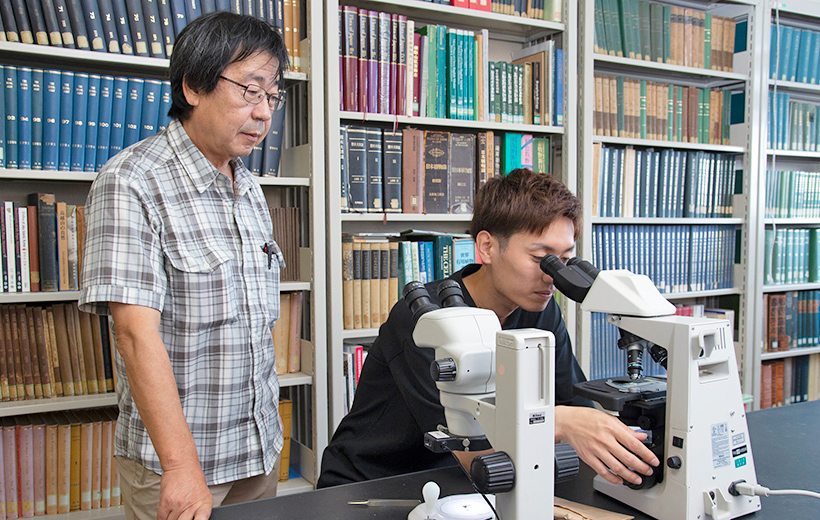
Research on Leucobryaceae has been continued
since his doctoral thesis even by using
genetic-level analysis
Prof. Yamaguchi’s most favorite bryophyte is Leucobryaceae. The taxonomy of the genus Leucobryum, which mainly lives in tropical and subtropical zones, is his long-standing research subject since his doctoral thesis. Although the morphological research is almost done, he continues research using molecular data because many species of the family Leucobryaceae have not been identified yet due to the family’s high degree of variation. “Species of the family Leucobryaceae are morphologically less distinguishable, so their classification and systematic identification are very difficult. For this reason, we now analyze their molecular data, or DNA,” he says.
What aspect of bryophytes attracts him so much? Prof. Yamaguchi says: “Bryophytes live modestly in places to which people pay less attention, but some of them are quite unique. It’s fun to find such species and observe them. In addition, bryophytes are comparatively easy to analyze their DNA. This is advantageous as research material because we can easily conduct various kinds of systematic analysis using molecular data.”
He also says: “The biggest advantage of bryophytes is that they can be found everywhere. They are strong against drying up as well as high temperature and low temperature. So, wherever we go around the world, except deserts and the sea, we can find bryophytes. We can find them even in Antarctica and the Himalaya Mountains. Even in deserts, we can find a small number of bryophytes on the back of stones. If you walk up along a mountain ridge, you will finally find no plants but bryophytes. This is why, many bryophyte researchers like trekking and used to belong a trekking club in their student days.”
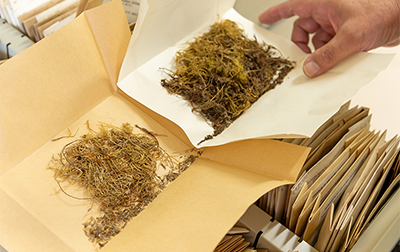
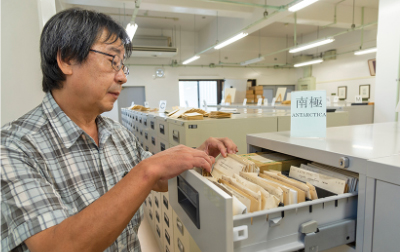
Interestingly, we can make specimens of bryophytes just by drying harvested plants without doing anything else. In addition, they are not eaten by bugs. “So, bug repellents are not necessary. And bryophytes are compact in size. A drawer of the herbarium has a capacity of 100 to 200 bryophyte specimens. Since there are only about 1,600 species of Japanese-origin bryophytes, a room with a size of 6 tatami mats could readily become a laboratory just by collecting the specimens of all bryophyte species in Japan and preparing a microscope. In fact, not a few high-school teachers earned an academic degree in this field while continuing their job,” Prof. Yamaguchi says.
And Prof. Yamaguchi will devotedly continue to observe bryophytes in the field, harvest specimens, investigate them at the laboratory, and add them to the said herbarium. This represents his commitment to an important mission—to pass his expertise on to the next generation.
He says that his minimum duty is to pass the herbarium on to the next generation and to foster as many bryophyte researchers as possible.
“I want to develop students’ knowledge and skills in field identification of bryophyte species because, these days, there are fewer bryophyte researchers who can identify species in the field from the characteristics of the place,” he says.
To pass forerunners’ precious legacies on to the next generation may be exactly the value and pleasure unique to this research.
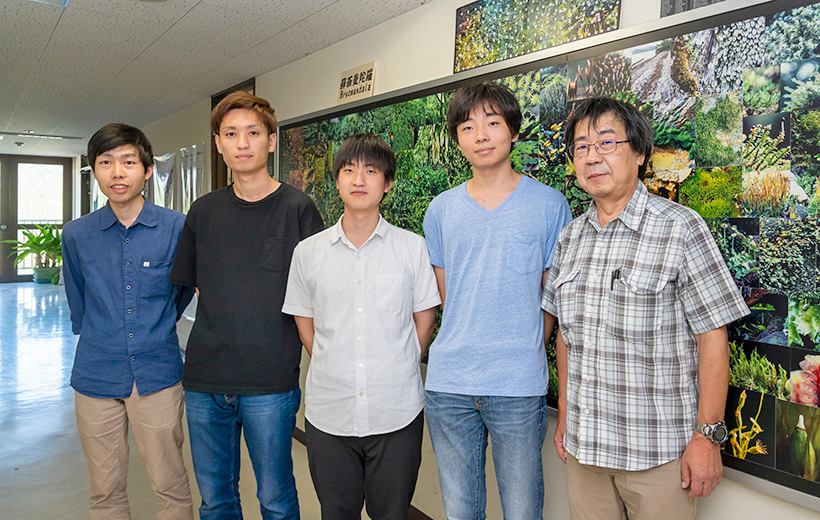 Opened on March 25, 2020
Opened on March 25, 2020


